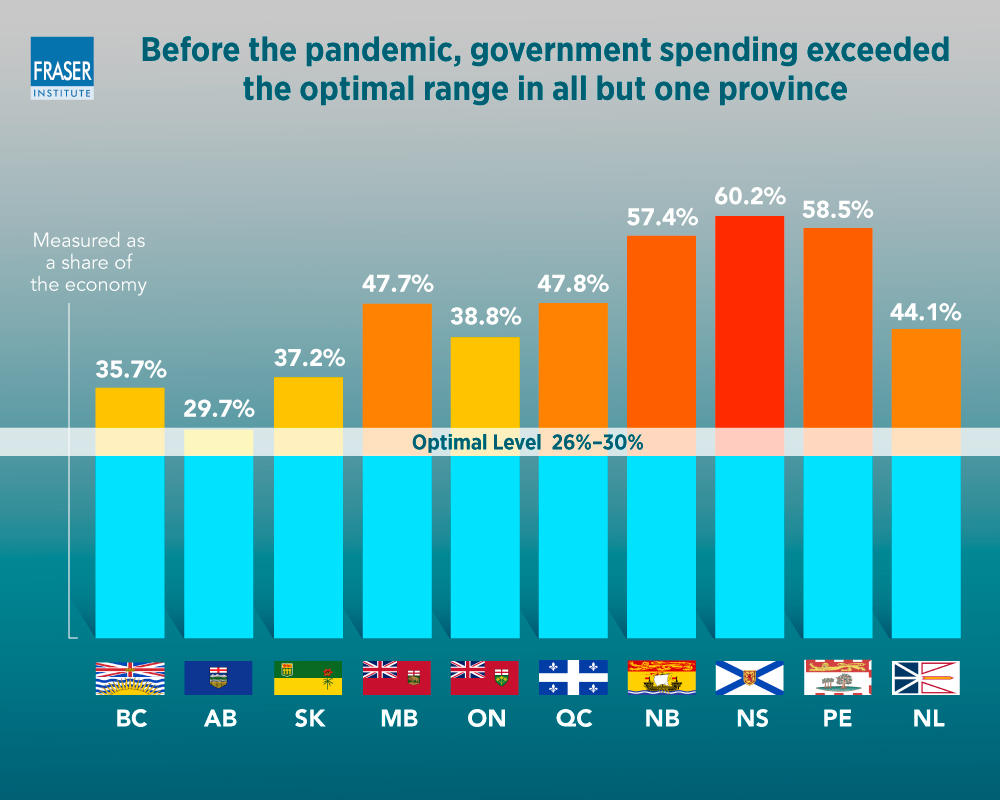Size of government—a pre-pandemic problem

During the pandemic, government spending in Canada increased substantially at the federal level and (to varying degrees) across the provinces. However, there’s an increasing perception that the current size of government (federal, provincial and local) is purely due to COVID. Quite the contrary, increases in the size of government (as a share of the overall economy) was a problem before the pandemic, and this matters because the size of government affects economic performance.
With the latest federal budget and many provincial budgets yet again promising more spending, it’s important to understand what was happening with the size of government in Canada pre-COVID. The period of 2007 to 2019 allows us to look at where the size of government, defined as total government spending as a share of the overall economy (GDP), stood immediately preceding the last two recessions. And 2019 is the most recent year of data, which excludes the pandemic.
The size of government in Canada over this period increased, meaning that government spending represented a larger share of the economy at the end period (2019) compared to the start (2007). Specifically, an increase in the size of government (federal, provincial and local) was found in eight of 10 provinces and for Canada as a whole between 2007 and 2019.
For Canada as a whole (including government at all levels), government spending represented 40.4 per cent of the economy in 2019, up from 37.4 per cent in 2007. Among the provinces, the size of government (again, measured as a share of the economy) ranged from 29.7 per cent in Alberta to 60.2 per cent in Nova Scotia in 2019.

There are several points of concern.
Alberta, for example, had the smallest size of government among all provinces in 2019 at 29.7 per cent of the economy. However, Alberta also recorded the largest change in the size of government during this period, up 5.5 percentage points in 2019 from 22.4 per cent in 2007. Newfoundland and Labrador experienced the next largest increase, up 5.2 percentage points in 2019, from 38.7 to 44.1 per cent.
In the Maritimes, the data are clear that even before COVID, the region had a large and growing government sector. In all three Maritime provinces, the size of government was approaching two-thirds of the economy. Total government spending in New Brunswick stood at 57.4 per cent of GDP in 2019, 58.5 per cent in Prince Edward Island and 60.2 per cent (the country’s highest level of government spending as a share of the economy) in Nova Scotia.
The only provinces to experience declines in the size of government prior to the pandemic were Saskatchewan and P.E.I. Saskatchewan’s decline was minor, at 0.5 percentage points. P.E.I.’s government spending as a share of the economy declined 3.1 percentage points but it was previously the province with the highest level of government spending (as a share of GDP). Simply put, the size of government remains a challenge in P.E.I.
Why does this matter?
A key consequence of the size of government is its effect on economic growth. Research has shown that the optimal size of government is between 26 per cent and 30 per cent of the economy, with “optimal” defined as the size of government that maximizes economic growth. With all provinces except for Alberta (plus Canada as a whole) being above this range, government spending is impeding stronger economic growth. Weaker economic growth means fewer jobs, less investment, lower wages and generally lower living standards.
Another consequence of this large government footprint is higher taxes. Canada remains a relatively high-tax jurisdiction by many measures, including personal income tax rates, business income tax rates and tax rates on investment such as capital gains taxes. These high tax rates are needed to maintain a large and growing government sector. With most governments in Canada also relying on deficit-financing for spending, this situation could worsen as interest rates increase, potentially increasing deficits, which are simply deferred taxes.
In addition, government spending as a share of the economy underestimates the true size of government. Beyond spending, governments control parts of the economy and add costs through regulations and tax expenditures. For example, studies have found that indirect costs such as tax expenditures and regulation add costs equal to an additional 10.1 per cent and 10.5 per cent of GDP nationally.
As economies across Canada recover from the pandemic, a large amount of temporary spending will wind down. However, it’s crucial to understand that we had a size-of-government problem well before COVID. As governments in Ottawa and the provincial capitals make fiscal decisions over the coming year, they should remember that ever more government spending has real-world consequences.

